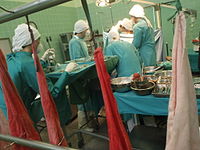
Photo from wikipedia
Inactivation of PERVs in the pig genome increases the safety of xenotransplantation Xenotransplantation, where tissue from one species is transplanted into a different species, is currently under development to help… Click to show full abstract
Inactivation of PERVs in the pig genome increases the safety of xenotransplantation Xenotransplantation, where tissue from one species is transplanted into a different species, is currently under development to help alleviate the increasing shortage of human tissues and organs for transplantation to treat organ failure. For several reasons, which include the size and physiology of the organs, the ease of genetic modification and cloning, and the large number of progeny and short reproduction cycle, pigs are the animals of choice for organ transplant in humans. Three major problems need to be solved before xenotransplantation becomes a clinical reality: immunological rejection, physiological incompatibility, and the risk of transmission of porcine microorganisms that are able to induce a disease (zoonosis) in the human recipient. On page 1303 of this issue, Niu et al. (1) demonstrate how to increase the safety of xenotransplantation.
Journal Title: Science
Year Published: 2017
Link to full text (if available)
Share on Social Media: Sign Up to like & get
recommendations!